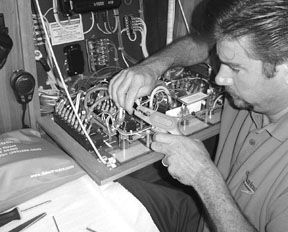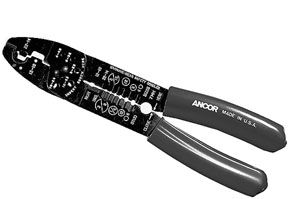No matter how large or small your onboard tool box, no matter how many wrenches, pliers, hammers, and putty knives you have cleverly packed away, the wire crimpers will always, always be at the bottom of the box. (Unless, of course, you left them in the bilge after your last repair).

The wire crimp tool is to a lug terminal as a deck cleat is to a dockline. A loose or improper connection is not acceptable. We all know the importance of properly terminating a wire connection, but is there one tool out there that is right for 90% of the wires that you are most likely to encounter onboard? Is that the tool in the bottom of your toolbox?
If you have any do-it-yourself interest in things electrical, you’ll need to think about which tools you need. In this article, we’ll tell you what the pros use, and test a sampling of crimpers and strippers commonly found at chain marine hardware stores, as well as those found at commercial electrical supply sources and ones found in the tool box of professional riggers. Our price scale runs the gamut, from $8 all the way to the $123 “Ultra Crimper.”
Crimping Tools
There are basically three classes of wire crimp tools: the multi-stripper/ crimp tool, the dedicated crimp tool, and the ratcheting crimper.
The multipurpose stripper/ crimper is probably one of the tools that is tucked away in the bottom of your tool cache. Most of these multipurpose tools are inexpensive transplants from the automotive industry. The “multi” usually consists of a stamped or forged set of handles that offer a simple wire cutter, a series of holes for stripping wire insulation, a light-duty machine-screw cutter, and a few crimping “stations.” Ancor Marine’s model DT0003 is an example of the multi stripper/crimper. The DT0003 has been “marinized” with chromed steel, but is still basically a plier-type crimper.
While the DT0003 is a decent specimen of the multipurpose tool, poorer, cheaper specimens abound in chain hardware and automotive stores, and electronics stores. You get what you pay for: Most of these tools yield a crimp quality just above what a normal set of pliers would produce. The cutting blade is barely adequate to cut #14 AWG cable. One set we have in the Practical Sailor office is of such poor quality that the cutting blades jump and overlap constantly, due to the weakness of the hinge and stamped-metal handles. If you have only very occasional wiring work to do, this type of tool (aided by some decent wire cutters) will do fine, but get one at least as good as Ancor’s DT0003; cheesy models will frustrate you and produce bad work.
An enhanced version of the Ancor DT0003 Multi is the Ancor 701007. This tool is also a plier-style multi-crimper. It includes the wire stripper holes, but yields a very nice box-style crimp on the lugs. The wire cutting blade suffers from the same inadequacies as the DT0003, due to its design.
Although the leverage on this tool is a little off because of the tool’s lightweight, low-cost design, we found the Ancor 701007 to be a pretty good general-purpose tool. It’s well worth the $14 price jump from the DT0003.
Dedicated Wire Crimp Tools
We randomly asked over 20 marine professionals (mast riggers, electronics installers, service technicians) from five top New England marinas what their favorite wire crimp tool is for wire between #22 and #10 AWG. The unanimous reply was the Klein #1005 crimp tool.
In our test of the Klein #1005, we found the tool to be heavy, but well- balanced and full of leverage. The front-mounted crimping sleeves make crimping in tight areas with one hand very convenient. The weight of the tool’s upper jaw held our lugs firmly in place as we positioned the wire into the terminal.
The Klein also has a nice set of heavy-duty wire-cutting blades, located in the tool’s front tip. With the tool’s excellent leverage, wire up to #10 AWG was cut with no difficulty.

We purchased our Klein crimp tool from Commercial Supply House Grainger for around $25, or about half the cost of a modest ratchet-style crimp tool. A quick search of the Internet returned multiple sites where the 1005 could be purchased for under $25.
The only drawback that we could find with this tool was the lack of integral wire strippers, as found on the multipurpose tools. (It should be noted that none of the more expensive ratchet-style crimp tools contain on-board wire strippers either.)
After crimping several dozen terminals with the Klein, it was easy to see why this tool is a favorite in the professional rigger’s bag. The 1005 crimps are neat and clean, and there was no hand fatigue, as we had experienced with the lighter-weight multipurpose tools.
Ratchet-Style Crimp Tool
When it comes to ratchet-style crimp tools, matching the correct lug termination to the wire size is everything. We tested the Ancor #702017 and #701030, and after a few botched crimps we were able to produce satisfactory crimps.
Using a ratchet-style crimp tool in tight quarters with one hand is almost an impossibility, especially if you have to release the lever on the ratchet mid-crimp. This tool is best left for wire crimps on a repair bench, or on an electrical panel that has ample elbow room.
The Ultra Crimper?
So what does the $123 Ancor 702015 double crimp ratchet do that other crimp tools don’t? The 702015 applies a double crimp to the wire terminal, which secures the jacket portion of the wire to Ancor’s lug terminal. This secondary crimp provides an additional strain relief to the terminal and/or to an end-to-end splice. The tool also yields crimp connections that are certified by ABYC.
Our take on this tool is that it’s overkill for routine vessel maintenance and repair. This tool was designed for attaching lug terminals in a production environment.
Certified crimps are most often used by manufacturers of mission-critical components (fire-suppression systems, electronic engine controls, monitoring sensors, etc.) where the crimping die on the tool has been closely matched to the lug terminal, and where uniform, redundant crimps are required.
Wire Strippers
If your task is just to reconnect the wires on a new bilge pump installation, or add a new terminal to your running-light wires, chances are that a dedicated wire-stripping tool is not going to be a valued member of your vessel’s toolbox. The wire-stripping holes on a multipurpose tool or even a sharp pair of wire cutters will properly prepare the wire end. But if your task is a little more involved—say that you’re adding a few 12V DC circuit breakers to your panel, or splicing together a multicore cable via a terminal strip—then a dedicated wire-stripping tool is the way to go. The dedicated strip tool will allow you to control precisely the amount of insulation that you remove off of each wire, which in turn will allow you to have uniform-looking wire lengths.

We tested Ancor’s low-cost multi- purpose 701007 wire crimper with integral wire stripper, against the Ancor 702030 and Ideal Stripmaster 292 dedicated wire strippers on multiple pieces of Ancor AWG 14 boat cable. All three tools easily removed 100% of the wire’s insulation with out damage to the wire conductors. Ancor’s multipurpose tool was the most awkward to use because the wire stripping jaws are located aft of the tools fulcrum, and required a large amount of space to operate. The Ideal Stripmaster 292 is a tool that has been on the market for over 30 years. This is a front-loading tool with gripper pads that clamp down and securely hold the wire while cutting blades strip off the insulation in a controlled one-squeeze process. This tool is a snap to operate, and frankly is quite fun to use. The Stripmaster’s major drawback is that the tool must be stored with its spring loaded handles in the full open position, which means that it will take up a good deal of space in your tool box. The Ancor 702030 automatic wire stripper is a lightweight tool that is also front-loading. It can automatically handle wire ranging in size from 24 to 12 AWG. Unlike the multipurpose tool or the Stripmaster, which require you to insert your wire into the correct stripping jaw, the 702030 automatically adjusts to different wire sizes. Although the 702030 doesn’t have the Edward Scissorhands moves of the Ideal Stripmaster, it’s a modern tool that is easy to use, and should be considered a candidate for your arsenal if your ambitions extend beyond routine maintenance.
Conclusions
The finish on your project will be reflective of the quality of the materials you start with. If you’re serious about maintaining your vessel’s electrical system by yourself, and adding new equipment, then a dedicated wire crimp tool and an automatic wire stripper would be good investments. Alternatively, if you’re strictly preparing for at-sea or temporary repairs, a decent multi-tool will do.
So pop open the bottom tray of your on-board toolbox, dig deep, and fish out those old crimpers. Check the style of the tool that you own against its intended purpose. Then either give it a quick lube and a once-over with a clean rag and put it back where you found it, or consign it to your next tag sale.
Also With This Article
Click here to view “Do’s and Don’ts: Tips From The Pros.”
Click here to view “Value Guide: Electrical Tools.”
Contacts
• Ancor Marine, 800/424-WIRE, www.ancorproducts.com
• Ideal Industries, 800/435-0705, www.idealindustries.com
• Klein Tools, 800/553-4676, www.kleintools.com

































